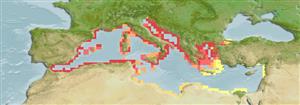>
Gobiiformes (Gobies) >
Gobiidae (Gobies) > Gobionellinae
Etymology: Pomatoschistus: Greek, poma, -atos = cover, operculum + Greek, schistos = divided (Ref. 45335).
Eponymy: Dr Hans Walter Bath (1924–2015) was a German ichthyologist. [...] (Ref. 128868), visit book page.
Environment: milieu / climate zone / depth range / distribution range
Ecologia
marino; salmastro demersale; distribuzione batimetrica 7 - 14 m (Ref. 92840). Subtropical; 46°N - 30°N, 6°W - 36°E
Mediterranean Sea: eastward into the Sea of Marmara.
Size / Peso / Age
Maturity: Lm ? range ? - ? cm
Max length : 3.0 cm TL maschio/sesso non determinato; (Ref. )
Short description
Chiavi di identificazione | Morfologia | Morfometria
Pectoral fin with 14-16 rays; males with several short bars on flank, mostly on lower half; females with 3-4 short bars on flank, mostly on lower half (Ref. 59043); body shape is terete, slightly depressed; eyes situated dorso-laterally; reduced swim bladders (Ref. 92840).
Found on sand and gravel in 7 m (Ref. 4696, 92840), muddy sand bottom in 10 m and rock sand ecotone in 14 m; meiofauna feeder; live together with G.geniporus, prefers benthic prey as well as fish and suprabenthic like harticoids and ostracods. (Ref. 92840). Max. length (Robert A. Patzner, pers. comm., 1999).
Life cycle and mating behavior
Maturità | Riproduzione | Deposizione | Uova | Fecundity | Larve
Miller, P.J., 1986. Gobiidae. p. 1019-1085. In P.J.P. Whitehead, M.-L. Bauchot, J.-C. Hureau, J. Nielsen and E. Tortonese (eds.) Fishes of the North-eastern Atlantic and the Mediterranean. Volume 3. UNESCO, Paris. (Ref. 4696)
IUCN Red List Status (Ref. 130435: Version 2024-2)
Threat to humans
Harmless
Human uses
Strumenti
Special reports
Download XML
Fonti Internet
Estimates based on models
Preferred temperature (Ref.
123201): 17.5 - 19.8, mean 18.9 °C (based on 311 cells).
Phylogenetic diversity index (Ref.
82804): PD
50 = 0.5001 [Uniqueness, from 0.5 = low to 2.0 = high].
Bayesian length-weight: a=0.00676 (0.00286 - 0.01601), b=3.05 (2.87 - 3.23), in cm total length, based on LWR estimates for this Genus-body shape (Ref.
93245).
Trophic level (Ref.
69278): 3.3 ±0.34 se; based on food items.
Resilienza (Ref.
120179): Medio, tempo minimo di raddoppiamento della popolazione 1.4 - 4.4 anni (Assuming fec < 10,000).
Fishing Vulnerability (Ref.
59153): Low vulnerability (10 of 100).
